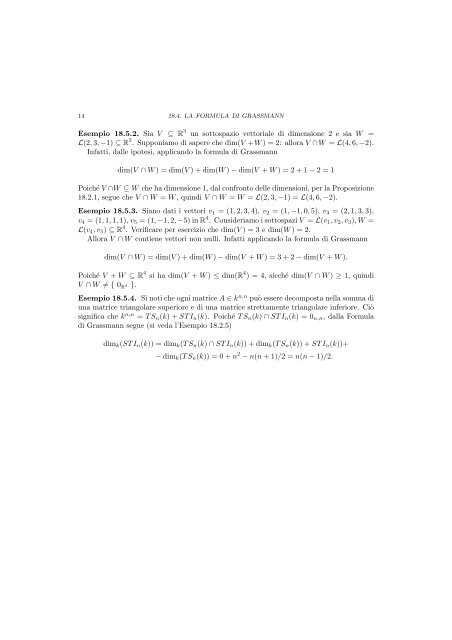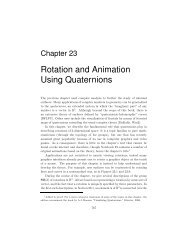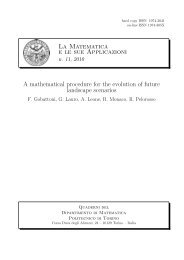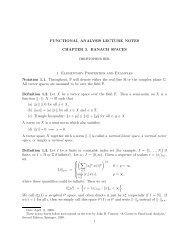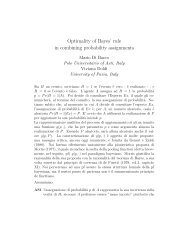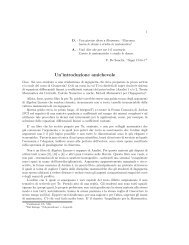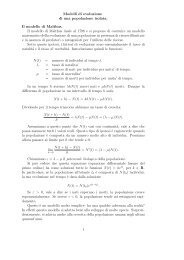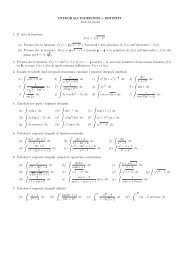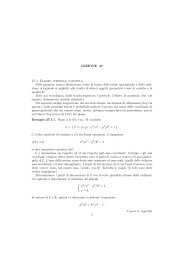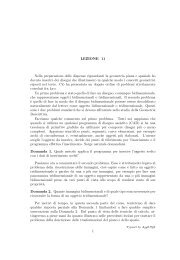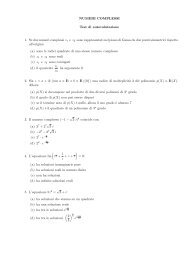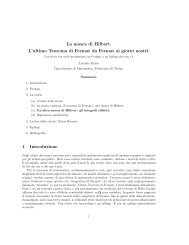Dimensione di uno spazio vettoriale. Dimensione di sottospazi
Dimensione di uno spazio vettoriale. Dimensione di sottospazi
Dimensione di uno spazio vettoriale. Dimensione di sottospazi
Create successful ePaper yourself
Turn your PDF publications into a flip-book with our unique Google optimized e-Paper software.
14 18.4. LA FORMULA DI GRASSMANN<br />
Esempio 18.5.2. Sia V ⊆ R 3 un sotto<strong>spazio</strong> <strong>vettoriale</strong> <strong>di</strong> <strong>di</strong>mensione 2 e sia W =<br />
L(2, 3, −1) ⊆ R 3 . Supponiamo <strong>di</strong> sapere che <strong>di</strong>m(V + W ) = 2: allora V ∩ W = L(4, 6, −2).<br />
Infatti, dalle ipotesi, applicando la formula <strong>di</strong> Grassmann<br />
<strong>di</strong>m(V ∩ W ) = <strong>di</strong>m(V ) + <strong>di</strong>m(W ) − <strong>di</strong>m(V + W ) = 2 + 1 − 2 = 1<br />
Poiché V ∩W ⊆ W che ha <strong>di</strong>mensione 1, dal confronto delle <strong>di</strong>mensioni, per la Proposizione<br />
18.2.1, segue che V ∩ W = W , quin<strong>di</strong> V ∩ W = W = L(2, 3, −1) = L(4, 6, −2).<br />
Esempio 18.5.3. Siano dati i vettori v1 = (1, 2, 3, 4), v2 = (1, −1, 0, 5), v3 = (2, 1, 3, 3),<br />
v4 = (1, 1, 1, 1), v5 = (1, −1, 2, −5) in R 4 . Consideriamo i <strong>sottospazi</strong> V = L(v1, v2, v3), W =<br />
L(v4, v5) ⊆ R 4 . Verificare per esercizio che <strong>di</strong>m(V ) = 3 e <strong>di</strong>m(W ) = 2.<br />
Allora V ∩ W contiene vettori non nulli. Infatti applicando la formula <strong>di</strong> Grassmann<br />
<strong>di</strong>m(V ∩ W ) = <strong>di</strong>m(V ) + <strong>di</strong>m(W ) − <strong>di</strong>m(V + W ) = 3 + 2 − <strong>di</strong>m(V + W ).<br />
Poiché V + W ⊆ R 4 si ha <strong>di</strong>m(V + W ) ≤ <strong>di</strong>m(R 4 ) = 4, sicché <strong>di</strong>m(V ∩ W ) ≥ 1, quin<strong>di</strong><br />
V ∩ W �= { 0 R 4 }.<br />
Esempio 18.5.4. Si noti che ogni matrice A ∈ k n,n può essere decomposta nella somma <strong>di</strong><br />
una matrice triangolare superiore e <strong>di</strong> una matrice strettamente triangolare inferiore. Ciò<br />
significa che k n,n = T Sn(k) + ST In(k). Poiché T Sn(k) ∩ ST In(k) = 0n,n, dalla Formula<br />
<strong>di</strong> Grassmann segue (si veda l’Esempio 18.2.5)<br />
<strong>di</strong>mk(ST In(k)) = <strong>di</strong>mk(T Sn(k) ∩ ST In(k)) + <strong>di</strong>mk(T Sn(k)) + ST In(k))+<br />
− <strong>di</strong>mk(T Sn(k)) = 0 + n 2 − n(n + 1)/2 = n(n − 1)/2.


